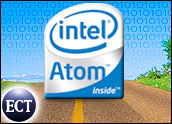
Intel began shipping its Atom Processor 330 Friday. The chip is the latest addition to the Atom product line and has been specifically designed to run on so-called nettops — desktop computers built primarily in order to surf the Web, send e-mail and perform basic Internet tasks, the company said.
“Intel always intended these for netbooks/nettop computers as well as what Intel calls ‘MIDs,’ — mobile Internet devices — which are smaller, handheld devices,” Tom Halfhill, an analyst at In-Stat and senior editor of “Microprocessor Report,” told TechNewsWorld.
The chip maker launched the Atom line to take advantage of a market that is steadily moving away from comparatively large desktop computers and toward a more mobile mentality.
“Intel has to move in this direction. Computing is going mobile. The desktop computers that Intel dominates now are going to be tomorrow’s mainframes. They are big, bulky computers used to solve big problems. Especially young people today, they don’t want to be tied down. They want a computer they can carry in their backpack or have a smartphone they can do some browsing with,” he said.
Hot Property
The Atom 330 is a dual-core processor, a first for the line. It features a 1.6 GHz processing core, 1 MB of level 2 cache divided over both cores and also supports DDR2 667 memory.
It is available as an integrated package and has been validated with the Intel 945GC Express Chipset, which features the chip maker’s built-in Graphics Media Accelerator 950 and High Definition Audio.
Built using Intel’s 45-nanometer dual-core architecture, the product line’s spotlight feature is its low level of power consumption. With its dual-core architecture, the Atom 330 offers 8 watts of thermal design power.
Compared with a VIA processor in the same class, Halfhill said, the Atom is in the same performance range and has as much power. It’s very competitive with what other manufacturers are offering, he said.
In these smaller Internet devices, “power consumption is everything,” said Halfhill. “The biggest problem that Intel has now is that the chipset designed to go with the Atom processor uses too much power. They got the power of the processor down, but the chipset uses a lot. They need a new chipset that consumes less power.”
How Low Can You Go?
Intel, said Halfhill, wants to go as low as it can in terms of power consumption so long as it does not comprise two key capabilities — support for the Windows operating systems and x86 compatibility.
“Those two things are going to limit how low they can reduce the power consumption, and that’s the problem for them. I can’t see them giving up on x86-compatibility. They’ve drawn a line in the sand there,” he noted.
Going into smartphones would put Intel into competition with ARM, according to Halfhill, though he added he’s not sure it will be able to lower the power consumption on the Atom enough to be competitive.
“The Atom will be successful in things like netbooks for sure. Now, whether Intel’s larger ambitions for Atom are successful, that’s a different question. Assuming MIDs are successful, they should do well there, but smartphones are more of a stretch. They’d have to get the power way down for that,” he said.



















































